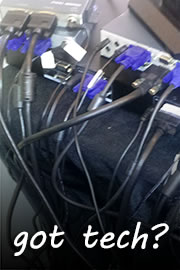PRLS Courtroom Presentation Services
 Why Hire a "Hot Seat" Tech?
Why Hire a "Hot Seat" Tech?
-
Pre-Trial tasks, such as organizing case materials and building the TrialDirector database and cutting depo clips. Interacting with document services vendors to help make sure scanned exhibits and trial binders are correct. Interacting with court reporting vendors, to help track down missing or replacement transcripts or video sync files. Interacting with court staff to determine the appropriate presentation equipment configuration for your courtroom, and to manage the install.
-
War room setup tasks, such as interacting with hotel IT and rental companies and overseeing the war room equipment install.
-
Afterhours war room trial prep, such as pre-treating documents for next day's trial, rehearsing witness examinations at the war room and designing the opening and closing statement PowerPoint presentations.
-
Presenting evidence during trial.
 The stress level involved when litigating a case can be right up there with going through a divorce or buying your first home. Wouldn't it be nice to just be able to focus on litigating the case, and not have to deal with laptops, cables and backup projectors?
The stress level involved when litigating a case can be right up there with going through a divorce or buying your first home. Wouldn't it be nice to just be able to focus on litigating the case, and not have to deal with laptops, cables and backup projectors?
Most attorneys never go to trial. Some go to trial only a few times in their entire career. Seasoned trial attorneys may see a handful of courtrooms per year.
By contrast, a "hot seat" tech is in various courtrooms and arbitration facilities throughout any given year, and know how to avoid or overcomemost common problems that may pop up. They know what equipment to bring, how to interact with staff without causing friction, and know how to coordinate equipment installs efficiently. Having the right tech helps minimize the duration of the trial, which in turn tends to have a positive impact on cost.
If you have questions or are ready to hire a tech, please complete our contact form.

 Trial Prep "Triage"
Trial Prep "Triage"
By Peder Rudling
Help!!! Your attorney just notified you that the trial everybody thought would settle or go away via Summary Judgment is instead actually going to TRIAL. The initial panic is starting to dissipate and you need a trial prep game plan. It is time to start addressing some basic questions about your trial prep readiness status, which generally falls into a few categories: Exhibit Binders, Documents, Deposition Videos, Transcript-Only Depositions, Graphics, Deposition Designations, People, Equipment, and Logistics. There is lots to do, so let’s get started.
Exhibit Binders
As soon as practicable, assemble your Master Set of Tabbed Exhibit Binders.
Common Problem: Even if you have already scanned the “universe” of case documents, trying to organize, convert, rename, and manipulate your home-made scans can be very time-consuming and thus expensive.
Solution: It is often cheaper and faster to have a document services vendor scan just the trial exhibits. The vendor picks up your master set of tabbed exhibit binders and returns duplicate exhibit binders containing branded “blowbacks,” and a disc containing the scanned images and a load file. (Be sure to let your document services vendor know your specific requirements with regard to file names, file formats, branding, and load files.)
How many duplicate sets of tabbed trial binders will you need – 5-6 sets? (1 for judge, 1 for witness, 1 for plaintiff, 1 for defense, 1 for war room, maybe more?)
Documents Scanned and Ready?
Are the files saved in the proper file format for TrialDirector and/or Sanction? (single-page or multi-page TIF, preferably, not just PDF) Are the files named properly by trial exhibit number and leading zeroes? (For example, exhibit 123, page 45, should be named 0123-045.tif) Are the pages “branded” with trial exhibit number? (The lower right corner of each page should have the file name printed, i.e. 0123-045) Have the scanned pages been straightened and checked for proper orientation? (portrait/landscape)
- If your document exhibits are scanned and ready, loading the documents into your presentation software should be easy.
- If your documents are not digitized, call your document services vendor to pick up and scan your master tabbed exhibit binders (see “Solution” above) or; if your documents are already scanned, organize, convert, rename, and manipulate your digital files (possibly time-consuming), or; if you have proper equipment and know what you’re doing, initiate the scanning process.
Synced Deposition Videos
Make a video inventory spreadsheet in excel, so you have at-a-glance awareness. In the spreadsheet, add a column to indicate what video depositions are present, and where they reside (either on disk, network drive, on trial laptop drive, or on external hard drive) Add a column to keep track of which depositions have sync files, and what type. (CMS or MDB) Send any un-synced files to your court reporting vendor for syncing. Indicate in the spreadsheet which sync files need to be converted to work with your trial presentation software. (CMS for TrialDirector. MDB for Sanction.) Your court reporting vendor is the first one to ask for help with this process. Add a column to keep track of which synced depositions have been loaded (and successfully tested) with the presentation software. Check for consistency in deponent names, volume numbers, and rename as needed to ensure that the depositions are listed in logical order and easy to find later on.
Transcript-Only Depositions
Deposition designations come in a few variations: Plaintiffs’ designations, Defendants’ designations, plaintiffs’ counter-designations, etc. Try to get an early sense for how many clips need to be created – can you handle the workload on your own, or should you put multiple people on the task to get it done? It is better to create a few extra clips in advance than waiting until the last few hours and suddenly realize that hundreds of clips weren’t done.
Clip creation script files are useful: The files are small enough for email. For large clip projects, multiple techs can help cut clips, and then email CCS files to the “hot seat” tech to drag and drop into TrialDirector. It is often faster to create CCS files with notepad and import and fine-tune in TrialDirector. To create individual clips, add hard returns between CCS lines, and then import into TrialDirector. To create multi-clips, add hard returns between CCS lines, and then import into TrialDirector.
Graphics
Graphics come in many forms and can vary greatly in cost. The type of graphic used should be driven by what features are needed to explain your case, not by what may “impress” the jury. How soon do you need the graphics? Complex graphics take longer to create. (To properly discuss this topic would require an article of its own.)
Equipment
Trial Laptops: Do you have at least two reliable trial laptops, primary and backup, properly configured and ready to go? Is the presentation software installed, activated, preferences configured properly? Do you have all the software utilities you need? (Word, Illustrator, PowerPoint, file renaming tools, Acrobat Pro, Photoshop, etc.) Determine the estimated size of your database and support files – do you have enough storage space to keep the entire case on your local drives, or will you need to keep the support files on an external drive?
Courtroom Presentation Equipment: Make a short list of what you plan to ask the courtroom clerk, so that you can make the most efficient use of the clerk’s time. Call the courtroom clerk from a quiet room, so you can hear what they say even if they whisper. Ask when would be a good time for you to visit the courtroom (to sketch the layout, figure out where the AC outlets are, etc.) Ask when the judge prefers to do the equipment install. What is the easiest way to get you and the equipment into the courtroom? Where to park? Which elevators to use? Ask the courtroom clerk if the courtroom provides basic presentation equipment. If they do, make sure the equipment includes at least a projector, screen, document camera, and VGA inputs for your attorney’s trial laptop. (Some clerks may not know the technical specifics, but may tell you they have a “NOMAD” system, for example.) If they don’t provide equipment, ask the clerk what is the recommended setup for their courtroom, what most attorneys use. This means you’ll need to make arrangements to either rent or bring your own setup.
People
Trial Tech: Who will be your primary trial tech? (Preferably an experienced contractor or in-house tech, someone who will not buckle under pressure.) Who is your second choice for trial tech, in case the primary tech becomes unavailable or in case one tech is not enough to handle the workload?
Judge and Court Staff: Every courtroom has its own “vibe.” Learn what “pet peeves” to avoid. Try to befriend the court staff, even if they are difficult.
Opposing Counsel: Are they hostile or civil? Figure out how you need to conduct yourself to make the trial as smooth as possible and don’t let anyone take you off your game.
If you and your team have found solutions for most or all the items in the above checklist, chances are good that you will have a positive trial experience, in spite of the last-minute nature of the process. Expect the first few days of trial to be extra hectic as both sides and the court staff find a way to move the process forward. Once you find a rhythm the process may even become fun.